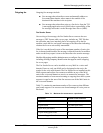
Addressing and networking
November 2004
Avaya Modular Messaging Concepts and
Planning Guide
6-15
careful consideration. Customers and planners are advised to
review Appendix C, Considerations with Message Networking
server, and should consult the engineering paper Message
Networking Implementation Notes. This engineering paper is
available upon request.
Modular Messaging—MSS and the Message Networking Server
It is important to plan for the Mailbox ID length, Numeric Address length,
and Network Address length when designing a network that involves
Modular Messaging—MSS and Message Networking. For example, in
some cases, depending on the Network Address length of the Message
Networking application (which is fixed in length), it may be desirable for
two Modular Messaging systems to send their subscriber directories
directly to each other rather than get routed through a Message
Networking application. This is so that the Network Address value for a
remote Modular Messaging subscriber on a local Modular Messaging
system is not fixed in length as would be required with a Message
Networking solution.
When a Modular Messaging—MSS system uses a Message Networking
server for communicating with other voicemail systems, certain features
are affected in the following manner:
No partial updates when addressing from the telephone user
interface (TUI)
Modular Messaging—MSS does not support partial updates when
addressing to remote subscribers from the TUI. When Modular
Messaging subscribers address messages to remote subscribers, from the
telephone user interface (TUI), recipients must be pre-administered on the
Modular Messaging—MSS as remote subscribers. This means that all
remote subscribers in the network must be added via an automatic
networking directory update or manually pre-administered on the
Modular Messaging—MSS system, to be able to receive messages
addressed from the Modular Messaging TUI.
Reply-all
Messages coming via a Message Networking server will not contain a
complete list of recipients because, the Message Networking server
cannot be sure that it received a complete list of recipients from the
originating node. Hence when using reply-all to messages coming via a
Message Networking server, the reply-all feature sends the reply only to
the originator of the message.


















